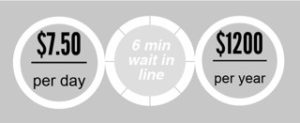Morgan Rees’21
Morgan Bramwell ’21
After the transition between food services, there is a plethora of opinions and emotions, both positive and negative, surrounding the changes implemented.

The original plan for the cafeteria changes was decided by a large committee of diverse perspectives to create a plan that would best suit the community. The first part of the new plan was the transition to SAGE Dining, which entails a few new members of the cafeteria staff. The second decision was the addition to the tuition, for an all inclusive program. The flat rate is 1,200 dollars, which is approximately $7.50 a day, which is equal to or less than the average student was spending last year. This does not include breakfast, coffee and the smoothie bar, as well as the canteen. However, the addition to the tuition does not increase as tuition increases. The final part of the transition was the expansion of the cafeteria, which, unfortunately, never occured, due to lack of funding. Members of the committee are continuing to try to make the expansion more of a possibility in the future. They have high hopes that over the course of the summer of 2019, the expansion will take place.
Students have mixed reactions regarding the changes to the cafeteria. One of the more prominent opinions was stated by Josephine Buccini ‘21, who explains, “I don’t believe that EA thought through changing our lunch plan to SAGE. If it was about healthier options, I am sure that could have been accomplished without switching our lunch plan. I, personally, have brought lunch every day my whole life, but now since lunch is included my family finds it a waste of money. I also know many people with this same reasoning. Lunch lines are now much longer because almost no one brings a bagged lunch for this very reason.”
Many of the other students agree that the lines are much larger, but Tommy Craig ‘19 argues, “I believe the efficiency at which students get their food outweighs the negatives of the new system.” In a recent study, it was concluded that the average time it takes for a student to receive their food and to sit in the seating area is about 5 to 6 minutes. This was conducted by 6 students over the course of two days from both lunches. This time, although seemingly little, is important to note because 6 minutes after the ending of the block prior to flex puts a student at a table around 11:00 – 11:05 which leaves only about 10 minutes to eat and clean up their meal before flex is over.
Sona Bardakjian ‘21 adds, “Without trays, it’s hard to hold your drink and plate and side of some sort. But on the other hand, that makes the disposing of the food a lot easier.” Although some agree that the disposal is easier, all students in the Upper School received an email within the first week of school warning students about disposing of their trash the right way.
Nikki Marzella ‘22 explains another popular opinion, “It would be great if we were offered more snack options because I know many kids that are still hungry after lunch but do not want to take a whole other entree. They would rather take something small to snack on. A larger selection of snacks and desserts would be nice to fulfill this request.” Many people agree that the daily snacks like granola bars, goldfish, baked goods, chips, pretzels, and pastries should be added back. Ned Meisel ‘22 opposes this popular statement saying, “I think the new lunch is a much healthier and very beneficial option for students. It is much more efficient than our old system.”
Head of School, T.J. Locke, Ed.D. expresses his opinions from an administrative standpoint stating, “I feel really good about two things, one being the decision to go all in for the addition to tuition instead of a la carte. The second thing would be the food. I think it is high quality and there are more healthy options for those who wanted them.” Unfortunately, the third part of the transition never occurred. The expansion of dining hall would have created more room for students to move around while filing their plate and getting food, so everyone is not so congested into one space.
As students recognize negatives in the new cafeteria, Locke reminds us all that, “The new cafeteria staff is noticing some bumps in the road, and you have to remember, it is only the third week of school. They intend on making it as smooth as possible for everyone involved.”